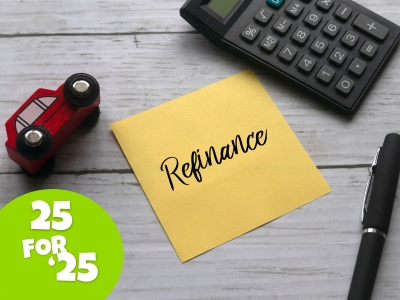25 Tips from the 1st CCU Fraud Team.
What is the 1st CCU Fraud Team?
In 2024 1st CCU, like many other financials, noticed a rapid rise in fraud activity amongst members and local communities. To combat this we assembled a specialized team of experts from various departments across the organization. Their purpose - inform and educate the 1st CCU staff, members, and the local community on trending scams and how to better recognize potential fraud. Since the creation of the group, 1st CCU's Fraud Team has helped save members thousands of dollars and create a knowledgeable staff.
Here are 25 Tips to help avoid scams and fraud in 2025:
- Do not give your Online Banking login information to ANYONE!
- Scammers will pose as employers and ask for your Online Banking credentials.
- Nobody (including 1st CCU) needs to know your login.
- Be Cautious about unsolicited emails.
- Do not click on links from unsolicited emails you weren't expecting.
- Do not open attachments unless you are certain it is legitimate.
- Be cautious about unsolicited text messages.
- Do not click links unless you are certain it is legitimate.
- Look the number up on Google! Many times common scams can be identified with this.
- Keep updated firewall and virus software on your devices.
- Use complex passwords. Phrases and other non-identifying words make great passwords that are more secure than short words.
- Keep an eye on your accounts!
- Monitor your accounts consisently with Online Banking or Mobile App.
- Report suspicious activity right away.
- Use 1st CCU as a resource. If you are unsure about something contact us! Our staff is here to help.
- Use trusted sites when shopping online.
- Look for the Secure Lock Symbol.
- Don't click website links from a social media ad or an email. Go to your browser and navigate directly to the official website.
- Don't purchase items through Social Media sites.
- Scammers love creating Facebook ads with links to spoof sites.
- Always use our secure browser to go to a company's website directly, then verify that the deal you saw on social media is legitimate.
- Fraudsters typically want you to act quickly.
- Don't rush. Stop and think before sharing information or sending money.
- Fraudsters will threaten with police action or other penalties if you don't do what they ask.
- Stop and think. It's likely not something you would get in trouble for.
- Family and friends asking for money is a red flag.
- Scammers will claim to be a family member or friend in trouble.
- Hang up, and call that person directly.
- Someone asking to be paid in bitcoin or other non traditional payment is a red flag.
- Fraudsters typically want payment that is untraceable.
- Fraudsters may tell you a "gag order" is in effect.
- They don't want you talking to others to avoid suspicion of fraud.
- Don't fall for the scam that involves someone claiming to be a 'cryptocurrency teacher' or 'bitcoin professor'. These scammers convince you to wire funds for purchasing bitcoin or other cryptocurrency, then when you attempt to cash out your investment you discover that they won't let you withdraw your funds.
- Share information and help protect other family and friends that are vulnerable.
- If it's too good to be true, it probably is!
- Become knowledgeable about the latest scam and fraud tactics. Look for information posted to official government websites such as the Federal Trade Commission, Internet Crime Complaint Center, or the Federal Bureau of Investigation.
- Know the red flags of a Deepfake Scam. Deepfake scams are AI-generated, and it's incredibly difficult to know when a video or audio recording are AI. One red flag is the audio not matching the video. Look for unrealistic eyes, fingers, facial features, etc. AI-generated faces can lack symmetry and have inconsistent lighting.
- Consider having a secret phrase with your loved ones. This is a question or phrase you ask that only the family or friend would know the answer to. Establishing this could help you verify that someone claiming to be your friend is actually a scammer.
- DO NOT send money to someone you haven't met.
- This includes online dating.
- It also includes people on social media asking you to help with moving money from an account into your account, and then moving it back out to a different account.
- Use eAlerts to notify you of activity in your account.
- Opt for Debit and Credit Card controls, such as the ability to turn off your card when you aren't using it.
- Enable two-factor authentication or online purchases or online/mobile banking transactions, when available.
- If you are being threatened, report everything to the police. Scammers will say anything to convince you to act quickly. They may claim to be the cartel or the mob. Scammers have been known to email pictures of graphic violence to threaten consumers, or they will tell you that they know where you live and they are coming to get you. Hang up and report it.
By staying alert and knowing the red flags to look for, you can significantly reduce the chances of falling victim to scams and fraud. It's also important to utilize robust services on your accounts and protections on your devices. Follow the ABC's...Always. Be. Cautious with your personal and financial details.
Congratulations, you're an adult and heading to college! There's no time like the present to start making smart financial decisions. Start by getting serious about your financial health. Manage your money and build spending habits that will set the stage for financial success in your future.
- Take Charge: Set goals for your time in college and refer back to them when you feel yourself slipping into bad money habits.
- Set Ground Rules: Discuss financial expectations with your parents or guardians: what they'll cover vs. what you’ll pay for.
- Get Organized: Stay on top of important financial and financial aid documents, and create a filing system to keep them in order. Designate a specific space in your dorm or apartment for safekeeping these very important papers.
- Lock It Up: You have roommates and they have friends you don't know, so be sure to keep sensitive information (like SSN, account numbers) in a secure place to avoid identity theft.
- Know Your Account Features: Make use of features like online banking, e-alerts and Bill Pay, and know your account's fees and requirements.
- Don’t Bounce Checks: Track your spending carefully to avoid overdrafts, as available balances may not reflect pending transactions.
- Be Smart About Choosing Your Meal Plan: Select the meal plan that fits your needs and, most importantly, use the meal plan instead of opting for fast food to help you avoid extra spending.
- Save On Snacks: Buy snacks in bulk to avoid overpriced vending machines, and keep some in your room or backpack.
- Resist Peer Pressure: Stick to your financial goals and say "no" to expensive activities that don’t align with your budget.
- Ground Rules for Roommates: Set clear expectations with roommates about household expenses and responsibilities, and avoid lending them money.
- Avoid Developing Bad Spending Habits: Don't take up costly habits like smoking, expensive coffee, gambling, or unnecessary subscriptions that can lead to overspending.
- Pay On Time: Always pay bills on time to avoid late fees and damage to your credit score.
- Separate Needs From Wants: Make spending decisions based on necessity rather than desire. Prioritize needs over wants.
- Student Discounts For The Win: Take advantage of student discounts at various stores and services to save money. They are out there, and some companies don't heavily advertise them. Seek them out to save on expenses.
- Avoid Random Credit Card Offers: Don't fall for campus credit card promotions. Avoid taking on high-interest debt.
- Build Good Credit: Use a single credit card responsibly, pay it off each month, and avoid cash advances or unnecessary fees.
- Transportation Tips: Walk or bike to save on parking and gas. If you need a car, combine errands to reduce costs.
- Part-Time Employment: If you need extra money, find a part-time job that won’t interfere with your studies. Be sure to check with your financial aid office first!
- Keep Up Your Saving Habits: Continue to put money aside in college, even if it's only a few dollars a month. Even small contributions to an emergency fund can help in times of need.
- Avoid Scams: Be cautious of scams targeting young adults, especially those asking for personal or financial information. These can include, but are not limited to, Fake Social Media Links, Job Scams, Romance Scams, AI-Voice or Deepfake scams, Scholarship Scams, and texts or emails with links to malware.
- Prepare Now For Your Future Career: Use campus resources like career fairs and interview prep to start building your career network and skills.
- Understand Your Financial Aid: Know what’s included in your financial aid package, if it’s a scholarship, grant, or loan you’ll need to repay, and whether your grades will have an impact on your financial aid eligibility.
- Seek Out Scholarship Opportunities: Talk to your financial aid office to find and apply for scholarships every year. They are there to counsel and advise you, so let them help!
- Beware of Scholarship Scams: Don’t pay for "guaranteed" scholarships. Legitimate ones are free to apply for and have clear contact info.
- Net Worth Does Not Equal Self-Worth: Value yourself for your character and achievements, not just financial success. Control your money, don’t let it control you.
At 1st Community Credit Union (1st CCU), we believe that instilling financial literacy in children from a young age is crucial for their future success. One effective and engaging method to teach kids about money is through gamification—integrating game-like elements into educational activities to make learning about finances both enjoyable and impactful.

The Power of Gamification in Financial Education
Gamification leverages the natural appeal of games to motivate and educate. By incorporating challenges, rewards, and interactive scenarios, children can grasp complex financial concepts in a relatable manner. This approach not only captures their attention but also fosters a deeper understanding of money management.
Practical Ways to Gamify Financial Learning
- Educational Board Games: Classic games like Monopoly and Payday introduce children to concepts such as earning, spending, saving, and investing. These games simulate real-life financial decisions, allowing kids to experience the consequences of their choices in a fun setting.
- Digital Apps: There are numerous apps designed to teach kids about money through interactive missions and quizzes. For instance, GoHenry offers a Visa debit card and financial education app tailored for children aged 6 to 18, combining real-world money management with engaging lessons.
- Role-Playing Activities: Set up a mock store or credit union/bank at home where children can role-play as customers or cashiers. This hands-on activity teaches them about transactions, budgeting, and the value of money in everyday scenarios.
- Savings Challenges: Create a savings goal chart with rewards for reaching milestones. This visual representation encourages children to set and achieve financial goals, reinforcing the importance of disciplined saving.
Benefits of Early Financial Education
Introducing financial concepts early equips children with the skills necessary to navigate the complexities of adult life. They learn the value of money, the importance of saving, and how to make informed spending decisions. Moreover, early financial literacy fosters confidence and reduces the likelihood of future financial mismanagement.
1st CCU's Commitment to Youth Financial Literacy
At 1st CCU, we're dedicated to supporting our community's youth in building strong financial foundations. We offer resources and guidance to help parents and guardians introduce sound money management practices to their children. By working together, we can ensure that the next generation is well-prepared to make informed financial decisions.
For more insights and tips on teaching kids about money, visit our blog post on smart money management for teens and kids.
By integrating gamification into financial education, we can make learning about money a fun and rewarding experience for children, setting them on the path to a secure financial future.
Buying or selling a home is one of life’s biggest milestones, but timing can make a significant difference in your experience—and your wallet. If you’re new to the housing market, you might be wondering: When is the best time of year to make a move? The truth is, the ideal timing depends on your goals, whether you’re buying, selling, or both.
At 1st Community Credit Union, with locations in Sparta, West Salem, and Tomah, Wisconsin, we’re here to help you navigate the home-buying process, no matter the season. Let’s break down what each time of year has to offer and how you can make the most of it.

Buying a Home: What’s the Best Season?
Spring: More Choices, More Competition
Spring is often seen as the peak home-buying season. As the snow melts and the days grow longer, more homes hit the market, giving buyers a wider selection to choose from. Families looking to move before the next school year often start house hunting in the spring, which can lead to increased competition. This competition may drive prices up, and sellers might not be as flexible with negotiations.
That said, if you’re prepared to act quickly and have your financing lined up—like a pre-approval from 1stCCU—you can still find great opportunities.
Summer: A Busy Market with Potential for Quick Moves
The momentum from spring continues into summer. While competition remains high, sellers are often motivated to close quickly, especially if they’re juggling their own moving plans. If you’re ready to move fast and can be flexible with closing dates, summer can be a great time to buy.
Fall: Less Competition, Better Deals
Once school starts, the housing market tends to cool down. Fewer buyers means less competition, and sellers who listed in summer might be more willing to negotiate. You’ll still find a variety of homes on the market, and you might score a better deal. Plus, moving in fall often means more availability for movers and contractors.
Winter: Fewer Listings, Lower Prices
Winter is traditionally the slowest season for real estate, but that’s not necessarily a bad thing. Sellers who list during the winter are often motivated to sell quickly, which can translate into lower prices and better terms for buyers. If you don’t mind a smaller selection and can navigate the occasional snow-covered driveway, winter can be a smart time to buy.
Selling a Home: Timing Your Sale for Success
Spring: Showcase Your Home’s Best Features
Spring’s blooming flowers and longer days create the perfect backdrop for selling a home. Curb appeal is at its peak, and buyers are eager to start their search. If you’re looking to sell quickly and potentially receive multiple offers, spring is your season—just be prepared to have your home market-ready.
Summer: High Traffic, High Expectations
Summer brings motivated buyers, often those who missed out in spring. It’s a great time to sell if you’re prepared for quick negotiations and can accommodate fast-moving timelines. Staging your home to highlight summer features—like outdoor spaces—can make your listing stand out.
Fall: Serious Buyers, Smooth Closings
By fall, buyers tend to be more serious about finding a home before the holidays. While there might be fewer showings, the buyers who do come through are often ready to make an offer. With less competition from other sellers, your home might stand out more.
Winter: Niche Market, Motivated Buyers
While winter has fewer buyers overall, those who are house hunting are often on tight timelines—whether due to job relocations or other personal circumstances. Pricing your home competitively and ensuring it’s warm and inviting can lead to a successful winter sale.
How to Decide What’s Best for You
Ultimately, the best time to buy or sell a house depends on your personal situation. Are you looking for the widest selection, the best deal, or the fastest move? Here are a few tips to help you decide:
- For Buyers: If you’re flexible and want the best price, fall and winter can be ideal. If selection is more important, spring and summer will offer more choices.
- For Sellers: Spring and summer usually bring the highest prices and quickest sales, while fall and winter might require more patience but could result in a smoother process.
Regardless of the season, having the right financing in place can give you an edge. That’s where 1stCCU comes in. Our friendly team can help you explore mortgage options, get pre-approved, and navigate the home-buying process with confidence.
Let’s Make Your Homeownership Goals a Reality
Whether you’re dreaming of buying your first home or ready to sell your current one, 1st Community Credit Union is here to help—no matter the season. Stop by one of our branches in Sparta, West Salem, or Tomah, or visit us online to get started. Together, we’ll find the perfect time for you to make your move.
When you turn the calendar to a new year or when you have a change in your life stage, it's a great time to look at your financial situation. By taking a series of thoughtful, disciplined steps you can improve your financial fitness in order to enjoy peace of mind in the future.
1st CCU is fortunate to have several employees who are well-versed in how to budget. Below you'll find 25 budgeting tips and tricks provided by Jim Farone, Loan Processor III for 1st CCU. Jim has been with 1st CCU since 2020 and he is always happy to share his knowledge with others.

Here are 25 Budgeting Tips & Tricks:
1. Choose a “Why”
Identifying your “Why” creates a sense of purpose and direction, making it easier to stay motivated when facing tough financial choices. Whether it's buying a home, traveling, or building an emergency fund, a clear goal will keep you focused.
2. Set Clear Financial Goals
Setting specific, measurable, and achievable financial goals helps you create a roadmap for your finances. Whether it’s paying off debt, saving for retirement, or building your emergency fund, knowing what you want to achieve will make budgeting easier.
3. Track Your Spending for a Month
Tracking your expenses will give you an honest look at where your money is going. This step allows you to identify areas where you can cut back and create a more efficient budget.
4. Choose the Right Budgeting Method – Zero Based Budgeting
Zero-based budgeting means allocating every dollar to a specific category, ensuring that income minus expenses equals zero. This method helps prevent overspending and encourages conscious decision-making about where your money goes.
5. Use Budgeting Apps
Budgeting apps like EveryDollar or YNAB (You Need A Budget) make it easier to track your income, expenses, and savings goals in real time. They automate much of the work, giving you insights and helping you stay on track without the hassle.
6. Create Your First Budget
Start by categorizing your expenses and comparing them to your income to see where adjustments need to be made. A simple budget is a great way to begin taking control of your finances and can evolve as your financial situation changes.
7. Be Realistic with Your Budget
It’s important to set achievable goals for spending and savings. If you make your budget too restrictive, you might give up; instead, aim for a balance that challenges you but doesn’t leave you feeling deprived.
8. Avoiding Common Pitfalls
Avoid underestimating variable costs or forgetting occasional expenses, like gifts or annual subscriptions. Many newcomers also forget to account for unexpected expenses, which can throw off their budget if not planned for.
9. Save Windfalls and Bonuses
Treat windfalls like bonuses or tax returns as unexpected found money and not as part of your regular income. These can provide an excellent opportunity to accelerate your savings or pay off debt without affecting your regular budgeting.
10. Set Up A Starter Emergency Fund
A basic emergency fund of $1,000 is a cushion for unexpected expenses. It’s a safety net that can prevent you from going into debt when life throws you a curveball, like car repairs or medical bills.
11. Use the Snowball Method
By paying off smaller debts first with the snowball method, you gain momentum and motivation as each debt is cleared. As each smaller debt is cleared, additional funds are freed up to apply to the next smallest debt and so on.
12. Pay Yourself First / Prioritize Savings
Treat your savings like a fixed expense, ensuring you set aside money for your future before paying for other items. This habit prioritizes your long-term financial well-being and builds savings without you having to think about it.
13. Automate Savings and Bills
Setting up automatic transfers ensures that your savings and bills are taken care of without you needing to manually handle each transaction. This reduces the temptation to spend and helps keep your finances on track.
14. Review and Update Your Budget Monthly
Your financial situation will change, so reviewing and adjusting your budget monthly helps you stay flexible and responsive to any new goals or unexpected expenses. This allows for continuous improvement in your budgeting approach.
15. Find an Accountability Partner
A friend, family member, or financial advisor can help you stay on track by checking in on your progress and offering support. Sharing your goals can increase your chances of success and create a sense of community around your financial journey.
16. Look for Ways to Save
Look for local events or free activities to enjoy without spending money. Many communities offer free outdoor concerts, museum days, or festivals. When shopping, be sure to shop with a list. Shopping with a list helps avoid impulse buys and ensures you only purchase what you truly need. It’s an easy way to stick to your budget and save money.
17. Use an Envelope System with Cash for Discretionary Spending
The envelope system involves allocating a set amount of cash to different spending categories. Once the money is gone, you can’t spend any more in that category, making it easier to control discretionary spending.
18. Setup Sinking Funds for Larger Expenses (Christmas, Car Repairs, Vacations, etc.)
Setting up sinking funds helps you save gradually for larger, infrequent expenses. This prevents these costs from derailing your budget and ensures you're prepared when the time comes.
19. Use the 48 Hour Rule for Online Shopping
Before clicking that Buy button on Amazon, let the item sit in your cart for 48 hours to give you time to evaluate if a purchase is truly necessary, helping you avoid impulse buys. By delaying gratification, you ensure that your purchases align with your long-term goals.
20. Invest for Your Future
Take full advantage of employer-sponsored retirement plans, especially if they offer matching contributions. Matching contributions is like earning 100% interest on your money! Aim to invest 15% of your income to build wealth for the future. If you can’t do 15%, don’t worry. Start smaller and work to increase your contributions by 1% or 2% per year.
21. Review Your Budget Annually and Adjust for Inflation
Inflation can impact your purchasing power, so it’s essential to adjust your budget yearly to reflect the rising cost of living. This ensures that you remain financially healthy even as prices increase.
22. Always be Learning!
The more you educate yourself about personal finance, the more confident you’ll feel making informed decisions. Regularly consuming content from financial experts keeps you up to date on the latest strategies and trends.
23. Share Your Journey
Talking about your financial goals can reduce anxiety about your situation. Whether it's with friends or online communities, sharing your journey can bring support and open up valuable discussions.
24. Celebrate Small Wins
Celebrating milestones, like paying off a credit card or hitting a savings goal, reinforces positive behaviors. Challenges like a “no spend” month can push you to improve your habits and make budgeting fun.
25. Build Healthy Financial Habits
Consistency is key in building strong financial habits. By focusing on small, achievable changes and sticking to them over time, you can create a solid foundation for long-term financial success.
Achieving financial fitness is similar to maintaining physical health; it requires discipline, planning, and regular monitoring. At 1st Community Credit Union, we believe that a well-structured budget is the cornerstone of financial well-being. By creating and adhering to a budget, you can take control of your finances, reduce stress, and work towards your financial goals.

Understanding Financial Fitness
Financial fitness involves managing your personal finances in a way that allows you to meet your current obligations while planning for future goals. It encompasses effective budgeting, saving, investing, and prudent spending. Just as physical fitness enhances your quality of life, financial fitness provides stability and peace of mind.
The Importance of Budgeting
A budget is a financial plan that allocates your income towards expenses, savings, and debt repayment. It serves as a roadmap, guiding your spending decisions and helping you avoid overspending. According to Harvard's Financial Fitness Basics, creating a budget is the first step to developing a workable spending plan.
Steps to Create an Effective Budget
- Assess Your Income: Begin by calculating your total monthly income, including your salary, bonuses, and any other sources of income.
- Track Your Expenses: Monitor your spending habits for a month to identify where your money goes. Categorize your expenses into fixed (rent, utilities) and variable (groceries, entertainment) costs.
- Set Financial Goals: Define short-term goals (e.g., building an emergency fund) and long-term goals (e.g., buying a home, retirement). Clear goals provide motivation and direction.
- Develop a Spending Plan: Allocate your income to cover your expenses and savings. Prioritize essential expenses and ensure you're contributing towards your financial goals.
- Monitor and Adjust: Regularly review your budget to ensure you're on track. Be prepared to make adjustments in response to changes in income or expenses.
Tips for Maintaining Financial Fitness
- Build an Emergency Fund: Aim to save at least three to six months' worth of living expenses to cover unexpected costs.
- Manage Debt Wisely: Focus on paying off high-interest debts first and avoid accumulating unnecessary debt.
- Automate Savings: Set up automatic transfers to your savings account to ensure consistent contributions.
- Live Within Your Means: Resist the temptation to overspend by distinguishing between needs and wants.
- Seek Professional Advice: Consider consulting with a financial advisor for personalized guidance.
1st Community Credit Union's Commitment to Your Financial Fitness
At 1st Community Credit Union, we offer a range of services to support your financial journey:
- Savings Accounts: Our savings accounts are designed to help you build your wealth over time.
- Financial Calculators: Use our online calculators to plan your budget, savings, and loans effectively.
- Educational Resources: Explore our blog and financial education resources for tips and strategies on managing your finances.
By partnering with us, you gain access to tools and expertise that can help you achieve and maintain financial fitness. Remember, just like physical fitness, financial fitness is an ongoing process that requires commitment and regular effort.
Start your journey towards financial well-being today with 1st Community Credit Union.
A loan refinance is the process of replacing an existing loan with a new one, typically from a different lender (or with modified terms from your current lender). The new loan pays off the old loan, and the borrower then repays the new loan under the updated conditions. In short, refinancing can be a powerful financial tool for borrowers looking to reduce costs, modify loan terms, achieve other financial goals, or simplify by moving all of their loans to one financial institution. Overall, refinancing could possibly help you reduce your loan costs, improve your payment structure, and provide financial flexibility...as long as the move is right for your unique financial situation.

Here are 25 things to consider:
Reasons to Refinance an Auto Loan:
- Lower Interest Rates: Refinancing can help secure a lower interest rate, reducing overall loan costs.
- Lower Monthly Payments: Refinancing may extend your loan term, which can reduce monthly payments.
- Improve Loan Terms: Refinancing can result in more favorable terms, such as a shorter loan term or better rates.
- Switch from a Variable to a Fixed Rate: Refinancing can allow you to switch from an adjustable-rate loan to a fixed-rate loan for stability.
- Access Better Lender Deals: You may find a lender offering more attractive terms than your original loan provider.
- Debt Consolidation: Refinancing may help consolidate multiple loans into a single, more manageable payment.
- Buy Out An Expiring Car Lease: By refinancing, you can transition from a lease to ownership, which means you'll no longer worry about mileage limits, wear-and-tear charges, or other restrictions or lease-end fees.
- Build Credit History: Refinancing could help improve your credit score by allowing you to pay off your current loan with better terms.
- Unlock Cash Flow: A lower monthly payment means more disposable income for other expenses or savings.
- Remove a Co-Signer: Refinancing can be a way to remove a co-signer from the loan if your credit has improved (or if your co-signer's credit has declined).
- Relieve Financial Stress: Refinancing can provide some financial relief if you're struggling with high monthly payments.
- Improve Loan Features: Refinancing can enable you to negotiate terms such as a deferred payment or a more flexible payment schedule.
- Take Advantage of Improved Credit Score: If your credit score has improved since taking out the original loan, refinancing can help you get better rates.
- Move All Your Loans To One Primary Financial Institution: Centralizing your loans at one financial institution makes it easy to access all your account information through a single online or mobile portal or account statement, saving you time when making your loan payments.
When is the best time to Refinance:
- When Interest Rates Drop: Refinancing is ideal when market interest rates have decreased since your original loan.
- After a Credit Score Improvement: If your credit score has increased significantly, you may be eligible for a better rate.
- At the End of a Promotional Loan Period: If you have a variable rate and your loan’s introductory rate period ends and the rate rises, refinancing can help you lock in a lower, stable rate.
- After Building Equity in Your Car: This is a financial strategy that can help you consolidate debt or pay for an unexpected expense. When the value of your auto exceeds the amount you owe on the auto loan, a cash-out equity refinance allows you to refinancing to a higher loan amount and receive the difference in cash. Essentially, you are borrowing against the equity in your vehicle.
- After a Major Life Change: Following a major financial event (e.g., promotion, tax refund, or inheritance), refinancing could help you adjust the loan to your new circumstances.
How to know if Refinancing is right for your situation:
- Current Loan Terms: If your current loan has a high interest rate or unfavorable terms, refinancing can improve your situation.
- Remaining Loan Balance: If you owe more than your car is worth, refinancing may not be a good option, as you might not get favorable terms.
- Total Loan Cost: Ensure the total cost of refinancing (including any fees) makes sense compared to your original loan. Sometimes, refinancing savings may not outweigh the fees.
- Consider The Impact To Your Overall Interest Costs: When you refinance, you may extend the term of the loan to reduce your monthly payments. However, while this might make your payments more manageable in the short term, a longer loan term means you may end up paying more in interest over the life of the loan, even if the interest rate is lower.
- Prepayment Penalties or Fees: Some auto loans include prepayment penalties* or fees if you pay off the loan early or refinance it. These charges can offset any savings you might have gained from a lower interest rate and make refinancing less beneficial.
- If It Will Negatively Impact on Your Credit Score: Refinancing can cause a temporary dip in your credit score. This happens because applying for a new loan results in a hard inquiry on your credit report, and closing the old loan may also lower your credit score due to changes in your credit utilization and account history. However, if you continue to make timely payments, your score may improve in the long run.
By understanding these factors, you can determine whether refinancing is a smart move based on your specific financial goals. Bringing your loan from another financial institution to 1st Community Credit Union could help you save time, money, and hassle.
If you're still not sure if refinancing is right for you, the friendly local lenders at 1st Community Credit Union are available to answer your questions and walk you through your options so you can make an informed decision knowing how a refinance could impact your financial health. Apply online to get pre-qualified, reach out to us with your questions or stop by 1st CCU during business hours in Sparta, West Salem, or Tomah.
*1st Community Credit Union does not charge prepayment penalties.
Becoming a homeowner is an exciting and rewarding milestone. However, managing a home comes with its own set of responsibilities. Whether you’re a first-time buyer or just new to owning your current property, there are several key tips to help you adjust to your homeowner role and maintain your home efficiently.

Below are 25 practical steps you can take to ensure your home stays in great condition while also providing a comfortable and safe living space.
- Know Your Home’s Systems: Understand the layout of your home, including the location of the main water shut-off valve, circuit breakers, and HVAC systems. Familiarizing yourself with these areas will be helpful in case of emergencies or routine maintenance.
- Inspect Regularly: Schedule regular inspections for things like your roof, plumbing, HVAC, and electrical systems. Catching problems early can save you money on expensive repairs down the road.
- Keep a Home Maintenance Calendar: Create a yearly maintenance schedule to keep track of seasonal tasks. This can include cleaning gutters, servicing the HVAC system, checking smoke detectors, or winterizing pipes.
- Prioritize Home Safety: Install smoke detectors, carbon monoxide detectors, and fire extinguishers in strategic locations. Ensure that your home is properly secured with locks on windows and doors and a working security system.
- Know Your Insurance Coverage: Make sure you have the right type of homeowner’s insurance. Check to ensure it covers not just the structure of your home, but also personal belongings and potential liability.
- Start a Home Improvement Plan: If you plan to renovate or improve certain areas, make a list of priorities. Plan your budget and timeline so that improvements can be done gradually and within your financial capacity.
- Landscaping and Lawn Care: Maintain the yard and outdoor areas. Regular lawn mowing, trimming bushes, and caring for plants not only improve curb appeal but also contribute to the longevity of your property.
- Get to Know Your Neighborhood: Build relationships with your neighbors, understand the community’s rules (if applicable), and learn about local amenities such as schools, grocery stores, and parks.
- Have an Emergency Fund for Repairs: While not all fixes come with a high price tag, brace yourself for the big-ticket items. These can include a new roof, new windows, new air conditioner, new appliances, etc. Sure, it might be more fun to use your cash for a kitchen renovation or bathroom remodel, but sometimes the “boring” expenses have to be put first.
You want your home to be enjoyable for you and your family, as well as keeping it updated to increase the value of your property. It’s easier than you think. Here are some top tips that will boost the value of your home.
- Curb Appeal: Colorful landscaping, a power-washed walkway or a fresh coat of paint on the front door can make your home look attractive and welcoming.
- Beautify your Bath: Replace an outdated vanity, old fixtures, lighting or add a new tile floor. A small investment can bring a big return and give your bath an updated, modern look.
- Kitchens are hot: Start by swapping out just one item, such as a chipped sink or old microwave for a shiny new stainless model. Small kitchen updates will add big value to your home.
- Pick up a paint brush: One of the easiest and most cost-effective improvements of all is paint! Freshly painted rooms in neutral colors look clean and updated.
- Make more room: Increase the living space by decluttering and removing the things you don’t need or use. Clean out your closets, thin out your shelves and remove furniture that blocks traffic flow.
- Go big: Feeling claustrophobic? Converting an unfinished attic or basement is always a great way to gain some extra space at a much smaller cost than building an addition. Adding a deck is another simple way to increase your space and make the most of it.
As a homeowner you have the freedom to make changes to your home so it fits your family and your lifestyle. Whether you’re hiring a contractor or a handyman, here are some tips to keep the lines of communication open and the repair project running smoothly:
- Ask around for recommendations for a Contractor: Before you choose a contractor, talk to your friends and coworkers about whom they’ve hired in the past and whether they were pleased. You may also want to check out a website – like www.angieslist.com – that lists local contractors and reviews about their work.
- Get multiple bids. It’s a good idea to shop around, compare prices and check out pictures of completed projects. But be respectful of others’ time. When you invite a potential contractor to discuss your ideas and see your space, be realistic about what’s possible, mindful of your budget and open to professional input.
- Ensure you’re speaking the same language. Your definition of “colonial style” might not be the same as your contractor’s. It may help to have pictures of what you’d like the finished product to look like. Consider visiting a website like www.houzz.com for design ideas and examples of your color and design preferences.
- Put it in writing. Determine up front what you’re willing to spend and ensure the details of the project are all in the contract. If you request a change to the original plan, you will probably be asked to sign a change order, which includes a detailed description of the change and the cost.
- Be friendly. You and your contractor are on the same side, seeking the same positive result. Keep in mind that construction can be a noisy, messy thing. Try not to let it irritate you. And be aware that weather can influence the schedule; if it’s raining, outside work may be delayed. Try to be patient.
Making smaller home improvements? With good planning – and a consideration of your skills and free time – you could save a good chunk of cash on your next project by becoming a weekend DIY warrior! Here are some tips:
- Evaluate how much of the work you can realistically do yourself. For instance, if you’re looking to add a room onto your house, perhaps you can paint the walls and stain and varnish the trim when it’s complete.
- Set priorities. Focus on improvements that will give you the most bang for your buck first. Decide what is critical and what isn’t. You may need to rethink the scale of your project to fit your budget, and you may find simple changes – such as new fixtures, a different paint color or improved lighting – can alter the feel of a room without gutting out and overhauling the entire space.
- Consider less costly alternatives to project details. Do some research. You may not be aware of some of the new options available to help your vision become a reality, such as a prefabricated fireplace unit vs. traditional masonry. Or laminate or linoleum countertops instead of granite. Or stock cabinets instead of custom ones.
- Try to schedule your project for an “off” time of year. For instance, schedule your central air installation in winter, not summer.
- Shop for materials that are on sale. Building supply stores often mark down items due to overstocks or other factors.
Homeownership is a journey that requires ongoing attention and effort. By understanding your home's systems, staying on top of maintenance tasks, ensuring safety and security, and preparing for emergencies, you can make your new home a comfortable and functional space for years to come. Taking small steps to stay organized and informed will help you navigate the responsibilities of homeownership with confidence.
If your home projects require financing, contact the local lenders you trust at 1st Community Credit Union. Our experts can help you choose the home loan option that best fits your budget.





